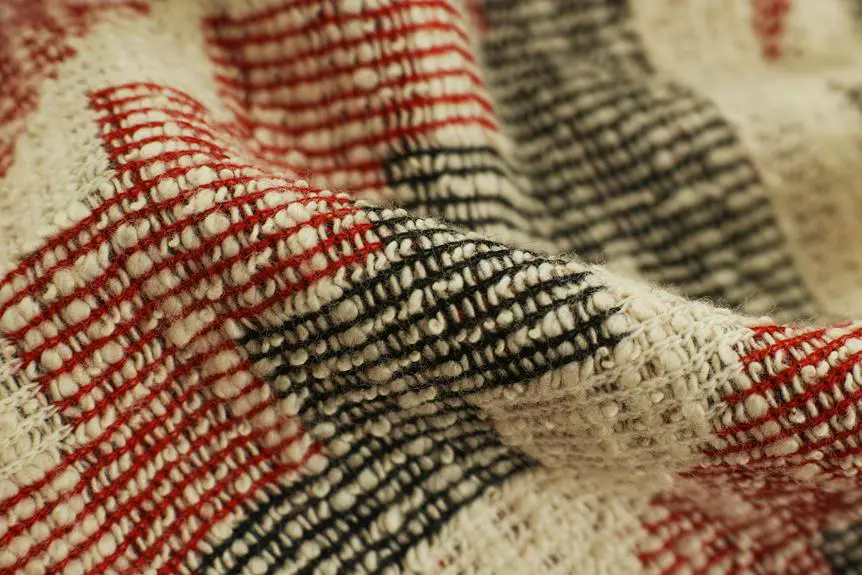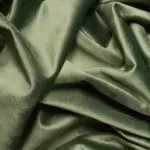When you think about seersucker and denim, you might notice they're not just different fabrics; they serve unique purposes in your wardrobe. Seersucker's lightweight, crinkled texture makes it a go-to for summer, while denim's durability and versatility fit various occasions year-round. But how do their care requirements and styling possibilities stack up against each other? Understanding these key differences could really enhance your fashion choices and help you make the right selection for any event.
Table of Contents
Fabric Composition
Seersucker's lightweight, crinkled texture comes from its unique cotton blend, while denim's sturdy feel is made from woven cotton or a cotton-polyester mix.
When you look at seersucker, you'll notice that it often incorporates a blend of cotton with synthetic fibers, enhancing its breathability and moisture-wicking properties. This makes seersucker a popular choice for warm weather, as it allows air to circulate, keeping you cool and comfortable.
On the other hand, denim's fabric composition primarily consists of cotton, which gives it that classic ruggedness.
Depending on the brand or style, you might find denim mixed with a bit of elastane or spandex, adding stretch for better fit and comfort. This blend helps denim garments maintain their shape over time, making them durable and versatile.
Texture and Feel
When you touch seersucker, you'll immediately notice its uniquely textured surface, which feels light and slightly crinkled, while denim offers a smooth yet sturdy sensation, giving you a sense of durability. The contrast between these two fabrics is striking, and it greatly influences how you feel in them.
Here's a quick comparison of the textures and feels of seersucker and denim:
| Feature | Seersucker | Denim |
|---|---|---|
| Texture | Crisp, crinkled | Smooth, woven |
| Weight | Light and airy | Heavier and robust |
| Flexibility | Soft and flexible | Stiff yet molds over time |
| Comfort Level | Cool and breezy | Cozy and form-fitting |
Choosing between these two fabrics comes down to what you want to experience. Seersucker is perfect for warm days when you crave a light, relaxed feel. On the other hand, denim gives you that comforting embrace, making it ideal for cooler weather or when you want something more substantial. Each fabric has its own charm, catering to your unique preferences and needs.
Breathability Factors
Breathability plays a significant role in how comfortable you feel in seersucker and denim, especially in varying weather conditions. When temperatures rise, you want fabrics that allow air to circulate and keep you cool.
Seersucker, with its unique crinkle texture, is designed to lift away from your skin, promoting airflow. This makes it an ideal choice for hot, humid days.
On the other hand, denim is generally thicker and less breathable. While it offers durability and style, it can trap heat against your body, making it less comfortable in the sweltering months. If you're planning a day outdoors, consider your activity level and the climate when choosing between these two fabrics.
Here are some key points to consider:
- Seersucker: Lightweight and airy, perfect for summer outings.
- Denim: Versatile but can feel heavy and warm in hot weather.
Ultimately, your choice depends on your comfort needs and the weather, so think ahead when dressing for the day!
Historical Background
Originating in the 19th century, seersucker has a rich history rooted in both Southern American and British fashion, designed primarily for hot weather wear. Its name comes from the Persian words 'shir o shakar,' meaning 'milk and sugar,' which reflects the fabric's unique texture and alternating smooth and crinkled surfaces.
You'll find that seersucker gained popularity in the American South during the early 20th century, where its lightweight and breathable nature made it a go-to choice for warm climates. Southern gentlemen often wore seersucker suits, especially during summer months, as a way to maintain style while staying cool.
In contrast, denim's history traces back to the 17th century in France, where it was first produced in the city of Nîmes, known for its sturdy fabric. Originally made for laborers, denim became synonymous with rugged wear by the mid-20th century, especially highlighted by its association with American cowboys and working-class individuals.
Both fabrics tell distinct stories of culture and utility, reflecting societal needs and fashion trends throughout the years. Understanding their historical backgrounds can deepen your appreciation for their unique characteristics.
Styling Versatility
Seersucker and denim both offer impressive styling versatility, allowing you to easily transition from casual outings to more formal events.
Seersucker's lightweight, crinkled texture gives it a laid-back, yet polished feel, making it perfect for summer weddings or brunch dates. You can easily pair a seersucker blazer with chinos for a smart casual look or wear it with shorts for a relaxed vibe.
On the other hand, denim is the ultimate wardrobe staple. It adapts effortlessly to almost any situation, whether you're going for a relaxed day out or dressing up for a dinner. A classic pair of dark jeans can be elevated with a button-up shirt and blazer, while distressed jeans offer a more relaxed, edgy look.
Here are some tips to maximize your styling versatility with these fabrics:
- Layering: Both fabrics work well with layers, so don't hesitate to mix and match with other pieces.
- Accessorizing: Use accessories to elevate your outfit, whether it's a statement necklace with seersucker or a leather belt with denim.
Seasonal Suitability
When considering your wardrobe choices, the seasonal suitability of seersucker and denim plays a key role in your comfort and style throughout the year.
Seersucker is a fabric that shines during the warmer months. Its lightweight, breathable structure allows air to circulate, making it ideal for hot and humid days. You'll appreciate how it keeps you cool while maintaining a polished look, perfect for summer weddings or outdoor gatherings.
On the other hand, denim serves as a versatile staple for cooler seasons. It offers durability and warmth, making it suitable for fall and winter wear. You can easily layer denim with sweaters or jackets without losing your stylish edge.
Whether you opt for dark washes or lighter shades, denim adapts well to various occasions, from casual outings to more formal events.
Maintenance and Care
When it comes to maintenance and care, you've got to consider washing instructions, ironing needs, and how long each fabric will last.
Seersucker and denim have distinct requirements that can impact your laundry routine.
Let's break down what you need to know to keep both fabrics looking their best.
Washing Instructions Comparison
To keep your seersucker and denim looking their best, it's essential to follow their specific washing instructions.
Seersucker is generally delicate, so you'll want to wash it in cold water to preserve its texture and colors. Avoid harsh detergents that can strip the fabric of its unique qualities. Instead, opt for a gentle detergent and consider a gentle cycle to prevent any damage.
Denim, on the other hand, is much more durable but still requires care. Wash your denim in cold water as well, but you can usually afford to use a regular cycle. If you want to maintain the color and fit, turning your jeans inside out before washing is a smart move.
Here's a quick comparison to keep in mind:
- Seersucker: Cold water, gentle cycle, gentle detergent.
- Denim: Cold water, regular cycle, inside out for color preservation.
Ironing and Wrinkle Care
Ironing seersucker and denim requires different approaches to keep them looking sharp and wrinkle-free.
Seersucker, with its unique crinkled texture, is designed to be low-maintenance. You won't need to iron it often, but if you do, use a low heat setting. Avoid steam, as it can flatten the fabric's signature puckered look. If you want to freshen it up, simply hang it in a steamy bathroom or use a fabric spray to release any light wrinkles.
On the other hand, denim demands a bit more attention. When ironing denim, you should turn the fabric inside out to protect its color and finish. Use a higher heat setting, but be cautious, as the fabric can scorch. If your denim is heavily wrinkled, consider using steam to help smooth it out without pressing too hard.
For both fabrics, always check the care label for specific instructions. Regularly hanging your garments after wearing can also help minimize wrinkles, making your maintenance routine easier.
Longevity and Durability Factors
Seersucker and denim each offer unique longevity and durability traits that hinge on proper maintenance and care.
When it comes to seersucker, its lightweight and breathable fabric requires gentle handling. You'll want to wash it in cold water and air dry to prevent shrinking and maintain its texture. Avoid using bleach, as it can damage the fibers and alter the color.
On the other hand, denim is known for its robustness. You can toss your jeans in the wash without much fuss, but you should still pay attention to the temperature setting. Washing in cold water can help preserve color and prevent fading. To maintain that perfect fit, avoid excessive drying, as heat can cause shrinkage.
Here are some quick tips to keep both fabrics looking great:
- Seersucker: Always air dry to prevent shrinkage and maintain texture.
- Denim: Wash inside out to retain color and avoid fading.
Frequently Asked Questions
Can Seersucker Be Worn for Formal Occasions?
Yes, you can wear seersucker for formal occasions, especially in warm weather. Choose tailored pieces and pair them with crisp shirts and accessories. Just ensure the overall look remains polished and sophisticated for the event.
How Does Denim Age Over Time?
Denim ages beautifully, showing off unique fades and distressing. As you wear it, the fabric molds to your body, creating a personalized look. Over time, those imperfections tell your story and add character.
Are There Eco-Friendly Options for Seersucker Fabric?
Yes, there are eco-friendly options for seersucker fabric. You can find brands using organic cotton, recycled materials, or sustainable production methods. Always look for certifications like GOTS or OEKO-TEX to ensure environmental standards are met.
What Are Common Color Choices for Denim?
When it comes to denim, you've got plenty of color choices. Classic blue and black dominate, but you can also find shades like gray, white, and even vibrant hues for a unique twist on your style.
How Do Seersucker and Denim Impact Body Temperature Differently?
Seersucker's light, crinkled fabric allows air circulation, keeping you cooler in hot weather. Denim, being heavier and denser, traps heat, making you feel warmer. Choose your fabric based on the temperature and comfort you want.
- How Does Ring Spun Cotton Affect Garment Fit and Shape Retention? - August 13, 2024
- What Are the Challenges in Producing Ring Spun Cotton? - August 13, 2024
- Is Ring Spun Cotton Suitable for Plus-Size Clothing? - August 13, 2024







